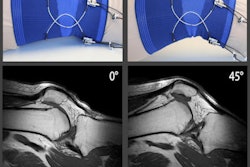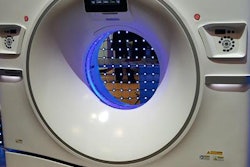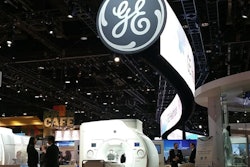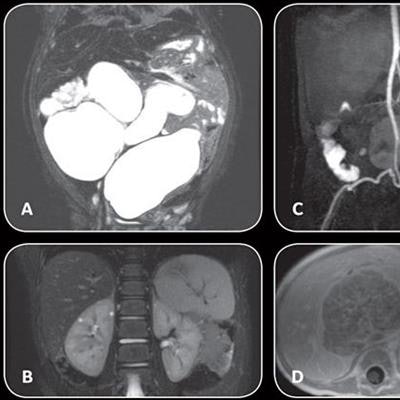
GE Healthcare is touting a new foldable, lightweight MRI coil design based on what it calls adaptive imaging receive (AIR) technology. The result is flexible enough to fit into your coffee mug.
The AIR coils offer new flexibility in design that was not possible with older coil technology, according to the company. For example, they can be incorporated into blankets that are far lighter and less of a burden to frail patients.
"Traditional coil technology can be rather bulky and heavy and difficult to handle," said Fraser Robb, PhD, an engineering manager at GE. "There are no real restrictions on how we can use the [AIR] technology, whether it's 1.5 tesla or 3 tesla. Since bodies come in all shapes and sizes, it can be useful for all body imaging."
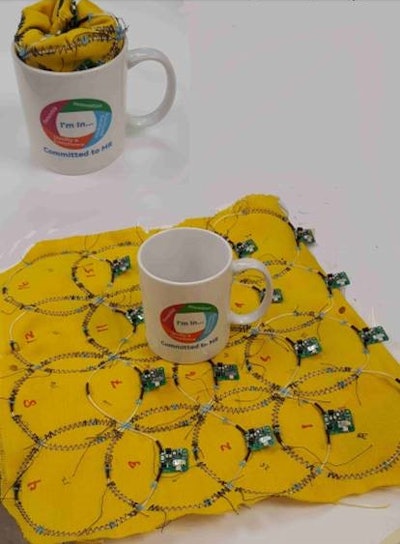 GE's flexible AIR coils can fit inside a coffee mug and function after unfolding. Image courtesy of GE Healthcare.
GE's flexible AIR coils can fit inside a coffee mug and function after unfolding. Image courtesy of GE Healthcare.Size matters
Conventional MRI coils can have their drawbacks. A less-flexible coil blanket can be difficult to position around an obese patient, for example. The blanket could also cause issues for premature or newborn babies: These infants often weigh less than the blankets and could have trouble breathing when the blanket covers them for a cardiac or body MRI scan.
GE has combined its proprietary Inca conductor technology with E-Mode electronics to produce AIR elements that function independently and are electrically immune to the surrounding environment or other neighboring elements. Component volume is reduced by more than 60%, and there is 95% more transparency for attenuation correction than with conventional MRI coils. In addition, with a weight of 40 g to 50 g per element, a blanket made of AIR coils is 60% lighter than conventional counterparts, according to the company.
Clinicians at Stanford University have been trying out the AIR coil blanket with pediatric patients. Under most conditions, small pillows are placed around a young patient to lift the weight of the coil blanket off the body. The placement of the coil, however, creates another imaging issue.
"Because of that positioning, the coil is farther away from the patient," said pediatric radiologist Dr. Shreyas Vasanawala, PhD, who is also director of MRI and chief of body MRI at Stanford University. "When that happens, you lose a lot of signal. Either your images are lower resolution or you have to scan longer to make up for that, which can result in motion artifacts."
In such cases, the lightweight AIR coil blanket can be positioned on the newborn's chest and does not present an impediment to breathing. It stays close to the chest wall and, because it is flexible, conforms to the shape of the chest. The AIR coils have helped Stanford clinicians perform congenital heart MRI scans on babies, for example.
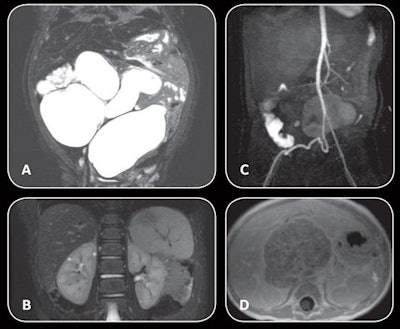 AIR technology coils are lightweight and can wrap around regions of interest, even in cases of severe abdominal pathological findings (A-D) and extreme musculoskeletal deformations. Images courtesy of Dr. Shreyas Vasanawala, PhD.
AIR technology coils are lightweight and can wrap around regions of interest, even in cases of severe abdominal pathological findings (A-D) and extreme musculoskeletal deformations. Images courtesy of Dr. Shreyas Vasanawala, PhD."We have also done pelvic and abdominal imaging with it," Vasanawala said. "For abdominal MRI, the parallel imaging performance of these coils is very critical in being able to image fast enough to freeze motion and perform an exam in one breath-hold."
With bone and joint imaging, the coil can wrap around a knee, thigh, or ankle. While an adult patient's joints are relatively the same size, pediatric patients can weigh as little as a few grams to as much as 100 kg, making their scans more challenging.
"The challenge with these scans is that you have to image the entire bone," Vasanawala said. "For instance, a femur is a very long bone. This new coil can wrap around that bone, or a thigh, or a leg."
The thin design of the AIR coil is also expected to benefit obese patients who may have a difficult time fitting into an MRI scanner. Again, the flexible coil and blanket are designed to conform to the patient's shape.
The AIR blanket coil has received 510(k) clearance from the U.S. Food and Drug Administration (FDA). GE plans to launch the accessory on its Signa Premier MRI scanner.





